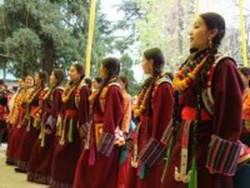Kalmyks
The Kalmyks are a group of people living mainly on the northwest shore of the Caspian Sea. They migrated to this area in the 16th century and as followers of the Tibetan form of Vajrayāna Buddhism they are Europe’s only native Buddhists. Throughout the whole of the communist era the Kalmyks were subjected to continual efforts to destroy their identity and their religion. In the 1930’s all Kalmyk monasteries were closed and all monks were exiled to Siberia. It is only since 1990 that Buddhism has begun to re-establish itself. Several young men have ordained as monks and been sent to India to study in Tibetan monasteries there. The most famous Kalmyk of modern times was the monk and scholar Geshe Wangyal (1901-1983), who lived in exile in America and had a profound influence on the development of Buddhism in that country. Today, most Kalmyks live in the Kalmyk Republic, an autonomous region which forms part of the Russian Federation. See Zaya Pandita.
The Kalmyk Mongols, P.G. Rubal, 1967.
